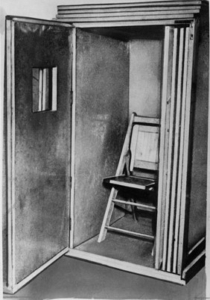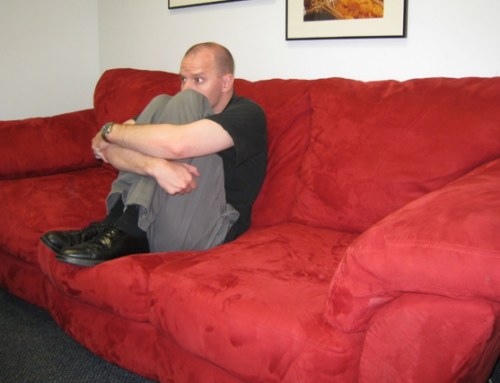Written By: Jay S. Efran, Ph.D., M.S., B.A.
Psychotherapy is a rapidly evolving field with everchanging traditions. Not long ago, it was considered de rigueur for patients to recline on their analyst’s couch six times a week. Moreover, analysts avoided keeping personal artifacts in their offices for fear of inhibiting the proper development of the transference. (This is despite the fact that Freud’s own consulting room was stuffed with statuary, photos, and other mementos.) It was Carl Rogers who helped loosen the grip of these stuffy practices. He met with his clients weekly, sitting upright in a rather ordinary-looking office.
Metallic Tractors and Energy Theories
Perhaps our field needs its own “cabinet of curiosities”—a kind of mental Mütter Museum in which to catalog various outmoded forms of practice.

For instance, it could have a display case devoted to the so-called “Perkins’ Tractor.” This consisted of two three-inch pointed metal rods which, when applied to different parts of the body, drew away the “toxic electrical fluids,” thought to be the cause of various ailments (see illustration above). Such tractors might still be in use except for the efforts of a clever physician who built a fake tractor out of wood (but colored to look like iron). Using that counterfeit, he easily proved that the reported “cures” had nothing to do with electrical fluids.
Our museum will certainly want to feature one of William Reich’s “orgone energy accumulators”— cabinetlike boxes made of alternating layers of organic and inorganic materials (see photo).
Reich claimed that sitting in such a box would replenish one’s supply of orgone energy, thus curing woes as diverse as impotence and the common cold. Amazingly, belief in this theory persists, and the American College of Orgonomy is still going strong.
Rebirthing
Moving a bit closer to our own time frame, the museum will need a wing devoted to Janov’s primal scream therapy and other re-birthing methods. This exhibit might also include a photograph of Pennsylvania psychiatrist John Nathaniel Rosen reparenting patients by holding them on his lap while feeding them milk from a baby bottle.
Invariant Prescriptions
We will want to have an exhibit about the “invariant prescriptions” of Italian psychiatrist Mara Selvini Palazzoli and her Milan team. One of the most famous of her treatment injunctions involved instructing parents to simply “disappear” from their homes without telling their adult or adolescent children where they were going or when they would return. Depending on the case, they might be told to stay away for as little as three hours and as long as three months. When they came back, they were prohibited from explaining where they had been or why they had left. In response to questions, they were merely to say, “These things concern only the two of us.” This family disruption method presumably led to miraculous cures. I am not making this up.
Family Tactics
A method that enjoyed considerable popularity—and is still being practiced today—is the “network therapy” of Ross Speck and Carolyn Attneave. This entails bringing together not just members of a client’s nuclear and extended family but also friends, workmates, and neighbors (often including their pets). Typical sessions would involve forty or more participants, all putting their heads together on behalf of the client.
Over the years, individual practitioners have contributed some distinctly odd procedures: For example, family therapist Murray Bowen reputedly sent clients home whenever he felt that they were becoming “too emotional” to do good work. Carl Whitaker, who had a reputation for wacky stunts, reportedly wiped his shoes on the dress of a woman with dirt phobias. On a different occasion, he met with a gay client who asked if Whitaker could help him. Whitaker replied: “Only if I am a better lay than any you have had so far.” The client responded by kicking Whitaker, who promptly kicked him back. The client then stormed out, never to return. Whitaker referred to this episode as a “one-session cure.” When asked how he knew the client had been “cured” rather than simply insulted, he brazenly replied that if the client had not gotten what he came for, he would surely have returned for more. I am not making this stuff up.
The Current Landscape
Each of these practitioners was working from a set of assumptions that he or she believed to be valid. Moreover, we all have a strong tendency to think that all of the field’s wackiness is in the past—that our current beliefs are “modern,” above-board, and valid. We forget that progress marches on and that future generations will consider some of today’s methods as primitive and outlandish as we now view bloodletting and snake workshop. What, for instance, are they apt to make of the tapping rituals of thought field therapy, the bilateral stimulation of EMDR, the current mindfulness craze, and the “inner parts” dialogues of internal family systems? While we await those verdicts, it would be extremely usefully for us to scrutinize the practices many of us take for granted. This would even include how we schedule sessions, set fees, and handle terminations. It would certainly involve reevaluating the emphasis many clinicians place on (a) exploring the past, (b) expressing feelings, and (c) correcting maladaptive thoughts. Such issues will be the focus of my upcoming workshop, titled Throwing Caution to the Wind: Challenging Therapy’s Core Practices.





